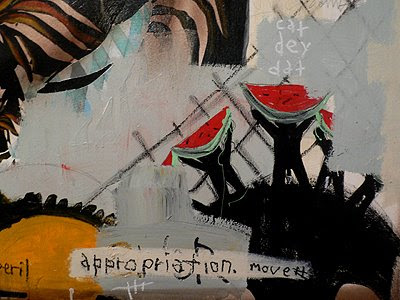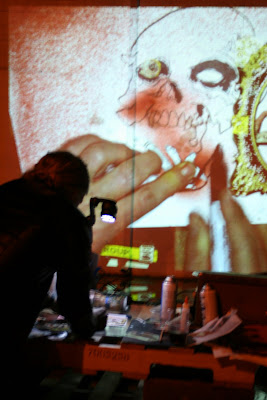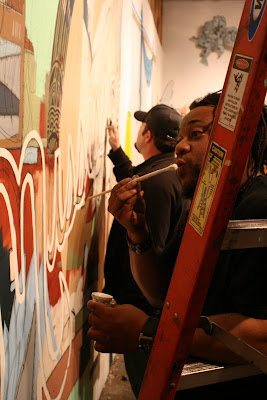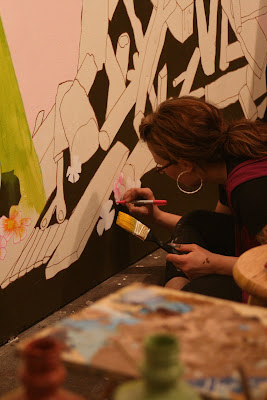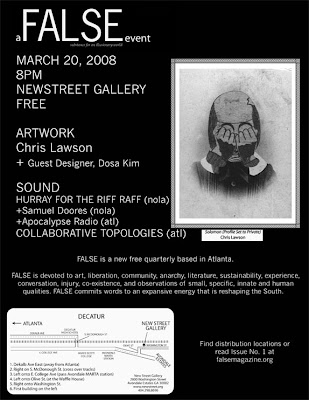Above: Obama “installation” by Shepard FaireyI admit I was a little shocked to hear
Shepard Fairey's name on the radio. But I suppose the man is fairly mainstream these days. Still... on a
podcast for Economist.com?Last week,
The Economist interviewed Scott Dadich, the art director of
Texas Monthly, about visual strategies and the evolution of “political branding.” Dadich's assessment of Barack Obama's
bumper sticker logo was especially fascinating. His words cut like a scalpel:
For the first time, we’re seeing the brand obsessed, and now design aware, corporate landscape in a presidential campaign logo. This is a really expertly done, clearly highly crafted piece of typography and graphic design. Designers are always trying to achieve additional, above-and-beyond meaning in their work. This “O” is a clear example of that effort. We have a sun rising over what appears to be a pastoral field. It’s almost reminiscent of the Bank of America logo.
The gist of the argument is that Obama's graphic messages are professional and highly effective. The Obama strategy is, from a design perspective, simply
superior to the other candidates', Democrat or Republican.
The interview continued on to analyze the significance of the Obama's stylized "O." Dadich calls it a "peelable" mark. Comparing the "O" to the Nike swoosh or the
Apple logo, the design is so distinct that this "O" can be removed and used as a stand-alone symbol for buttons, baseball caps, and merchandise of all varieties.
It only takes a moment to consider the infamous "W" in "George W. Bush" to see the contagious marketing power of a single, "peelable" initial. Dadich discussed the point a little further in his
2004 opinion piece in the
New York Times. Although this "O" revelation could form a point of pride for Obama supporters, it still drives home just how intensely commercialized our election system has become.
Dadich also takes up a comparison with a few "less successful" graphic campaigns, including a fairly uncompromising
critique of Kerry/Edwards. Some of his criticisms border on minutia - things that only a graphic designer would notice. His complaint about the letter spacing after Kerry's first initial struck me as a little obscure. But when you compare to the boldness and resolve embodied in the Busch/Cheney logo, the contrast of styles becomes crystal clear.
The
Economist interviewer then maneuvered Dadich through a number of subjects, including the role of graffiti artist Shepard Fairey and other independent designers. Evidently, Fairey 's larger-than-life Obama (photo above) can be seen all over the West Coast. Dadich cites Fairey's Obama as evidence of a
movement - not just one charismatic man.
The discussion even touched on the failed
Mondale/Ferraro bid for the White House back in 1984. The redundant typeface failed to distinguish the nominee, Walter Mondale, from his female running mate, Geraldine Ferraro. Ferraro, a savvy New York lawyer, received nearly as much media attention as Mondale.
At one point, Scott Dadich drew attention to the three star motif on the blue
Hillary Clinton logo. There are claims that the three stars allude to a third Clinton presidency. I don't give the theory much credit; it sounds a little too convenient and, for that matter, partisan in that predictable, talk radio sort of way. I mean, realistically, three stars could suggest anything: Orion's Belt, a fraternity
coat of arms, or the restaurant rating of the
Atlanta Fish Market.
My own intuition leans toward a more believable, although ironic, interpretation. Three uniform stars vaguely suggest
unity, like that
old apocryphal tale of St. Patrick explaining the Trinity by using a three-leaf clover. In Scott Dadich's words, the Clinton logo tries to represent "all things to all people." Maybe Hillary's team intended the stars to suggest a "Third Way," a compromise between the politically divided Left and Right. That was Bill Clinton's platform in 1992, but unfortunately for Hillary, the "unity" candidate this year is not her.
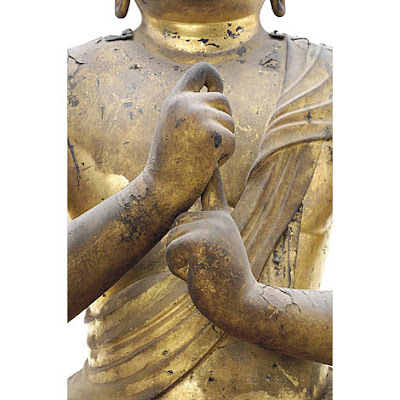 Above: Dainichi Nyorai, detail
Above: Dainichi Nyorai, detail








